
Wasps of the genus Sphex are cosmopolitan predators that sting and paralyze prey insects. Sphex is one of many genera in the old digger wasp family Sphecidae, though most apart from the Sphecinae have now been moved to the family Crabronidae. There are over 130 known Sphex species.

Sceliphron is a genus of Hymenoptera of the Sphecidae family of wasps, commonly referred to as mud daubers. They are solitary and build nests made of mud. Nests are frequently constructed in shaded niches, often just inside of windows or vent openings, and it may take a female only a day to construct a cell requiring dozens of trips carrying mud. Females will add new cells one by one to the nest after each cell is provisioned. They provision these nests with spiders, such as crab spiders, orb-weaver spiders and jumping spiders in particular, as food for the developing larvae. Each mud cell contains one egg and is provided with several prey items. Females of some species lay a modest average of 15 eggs over their whole lifespan. Various parasites attack these nests, including several species of cuckoo wasps, primarily by sneaking into the nest while the resident mud dauber is out foraging.

Pepsis is a genus of spider wasps belonging to the family Pompilidae.

Episyron is a genus of wasps in the family Pompilidae which prey on spiders. Nine species are found in Europe.

The Pompilinae are a subfamily of the spider wasp family, Pompilidae, the species of which lay their eggs on the paralysed bodies of their prey.

Anoplius is a genus of spider wasps in the family Pompilidae, called the blue-black spider wasps.

The Pepsinae are a subfamily of the spider wasp family, Pompilidae, including the tarantula hawks, as well as smaller species.
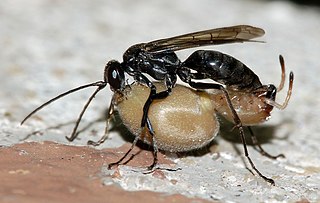
Auplopus is a large genus of spider wasps belonging to the subfamily Pepsinae of the spider wasp family Pompilidae, distributed throughout the world except for Antarctica. Auplopus wasps have the gruesome habit of amputating the legs of their spider prey before transporting it to the nest.
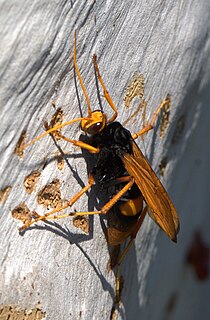
Cryptocheilus is a genus of spider wasps of the subfamily Pepsinae, they are found in the world's warmer regions. They vary in size from medium to large and are often strikingly coloured. The females construct multicellular nests in cavities, once built each cell is stocked with a spider, captured by the female. They are found in open habitats such as heaths, meadows and forest edges.
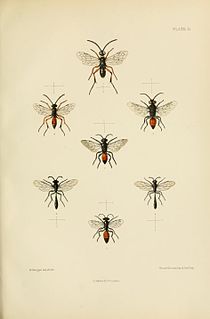
Ceropales is a genus of kleptoparasitic spider wasps from the sub-family Ceropalinae of the family Pompilidae. They are characterised by the taking of the spider prey of other solitary wasps, mainly Pompilidae but members of the Sphecidae that provision with spider prey are sometimes also hosts. In some languages their name translates into English as "Cuckoo Spider Wasp".
The Ctenocerinae are a subfamily of spider wasps, Pompilidae, which contains a small number of genera, two in the Neotropics, four in Australia and the remainder in Africa. Ctenocerine wasps have evidently evolved from a common ancestor with the Pepsinae, but are specialized for preying upon trap-door spiders (Ctenizidae).
Homonotus is a genus of spider hunting wasps with an old world distribution, mainly in Africa.

Evagetes is a genus of spider wasps from the family Pompilidae. There are 72 described species, of which 58 are found in the Palaearctic region, 11 in the Nearctic region, with a few penetrating to the Afrotropical, Oriental and Neotropic regions. Evagetes wasps are kleptoparasitic on other pompilid wasps, especially the genera Arachnospila, Anoplius, Episyron and Pompilus, digging into their sealed burrows, eating the host egg and replacing it with an egg of its own. Evagetes wasps are characterised by their very short antennae. Most are species are black with the base of the antennae rufous, several Evagetes species are very metallic bluish insects.
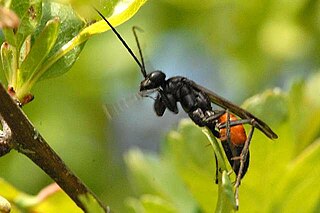
Arachnospila is a predominantly Holarctic genus of spider wasps, with limited representation in montane habitats in Neotropical and Afrotropical regions. They are found in open habitats and at forest edge, the nests may contain more than one cell.
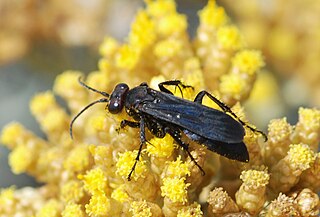
Agenioideus is a genus of spider wasps from the subfamily Pompilinae; the genus occurs in Europe, where 21 species are recorded, eastwards to Japan, in North America, South America, and Australia.

Cyphononyx is a genus of spider hunting wasps in the family Pompilidae.

Hemipepsis is a genus of large pepsine spider wasps found throughout the tropics. They are commonly known as tarantula hawks. Hemipepsis wasps are morphologically similar to the related genera Pepsis and Entypus, but distinguishable by the pattern of wing venation. In South Africa 18 plant species from three plant families, the Apocynaceae, Orchidaceae, and Asparagaceae subfamily Scilloideae are pollinated exclusively by Hemipepsis wasps.
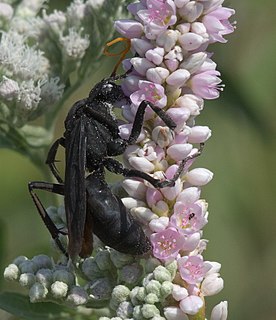
Entypus is a genus of spider wasps in the family Pompilidae. There are at least 40 described species in Entypus.

Pepsini is a tribe of spider wasps in the family Pompilidae. There are about 11 genera and at least 40 described species in Pepsini.
A list of the species of Hymenoptera from New Zealand; currently listing the 'stinging wasps' (Aculeata), which includes ants, bees, and social wasps.

















